Turkish archaeologist highlights Urartian settlements in northwest Iran

TEHRAN—Dr. Erkan Konyar, professor of archeology at Istanbul University, has delivered a lecture on Urartian settlements in northwest Iran, turning the spotlight on the ancient country once centered in the mountainous region southeast of the Black Sea and southwest of the Caspian Sea.
Addressing a host of archaeologists, historians, and cultural heritage enthusiasts at the National Museum of Iran late on Tuesday, Konyar emphasized the importance of northwest Iran in the Urartu kingdom and said: To the east of the Van Lake Basin, behind the northern Zagros Mountains, lies the Urmia Lake Basin, which contains the important plains and the Lake Urmia.
In his lecture titled “The Urartian Capital Tushpa and the Urartian Settlements in Northwest Iran”, Konyar discussed the capital of the Urartu, Tushpa, and its explorations, as well as its comparison with the Urartu settlements in the northwest of Iran.
Regarding the geography of Urartu, he said: Urartian geography can be divided into sections with different characters depending on its widespread area. This situation has affected many areas, such as house type, settlement style, and lifestyle.
Within these borders, Lake Van, Lake Urmiye, and Upper Basin contain important Urartian settlements. Regarding Tushpa, he said: The settlement of Tushpa, the capital of the Urartians, who established the central state structure in this geography in the 9th-7th centuries BC, plays a decisive role in understanding other Urartian settlements and architectural traditions.
“Tushpa-Van Rock, which was a pioneering model in the Urartian period, was not abandoned by the founding king Sarduri I until the collapse of the kingdom.”
Moreover, the archaeologist noted that some important royal centers of Urartu, such as Qalatgah, are also found in northwest Iran, which are not yet excavated and are potentially important for the Urartu researchers.
Konyar, who has done research on the culture and kingdom of Urartu in eastern Turkey and has numerous publications on the subject, is currently analyzing Hasanlu archaeological material that is housed in the National Museum of Iran.
The archaeologist directed the Kahramanmaraş Survey between 2006-2010 and the Van-Tushpa excavations, the capital of Urartu, between 2010-2019. Furthermore, he has three published books and four edited books. He has also published nearly 80 articles in various international journals.
Today, what was known as the Urartu kingdom (860 BC – 590 BC), is divided among Armenia, eastern Turkey, and northwestern Iran. Mentioned in Assyrian sources from the early 13th century BC, Urartu enjoyed considerable political power in the Middle East in the 9th and 8th centuries BC.
AFM
Leave a Comment